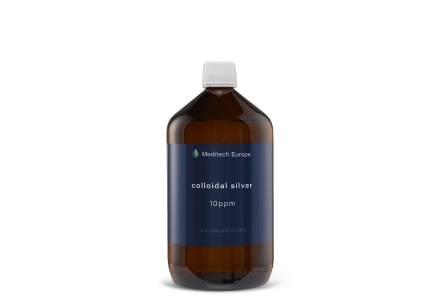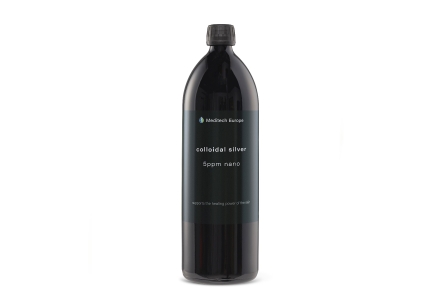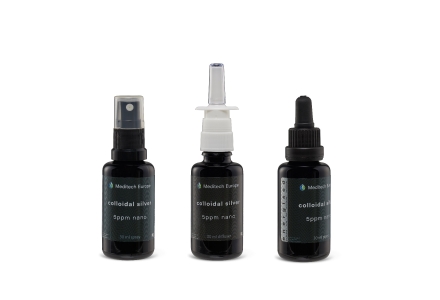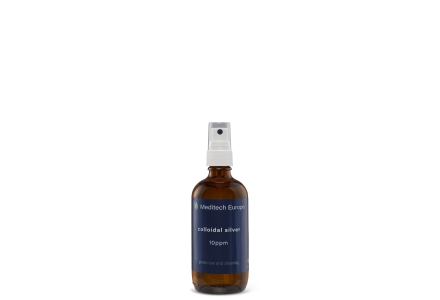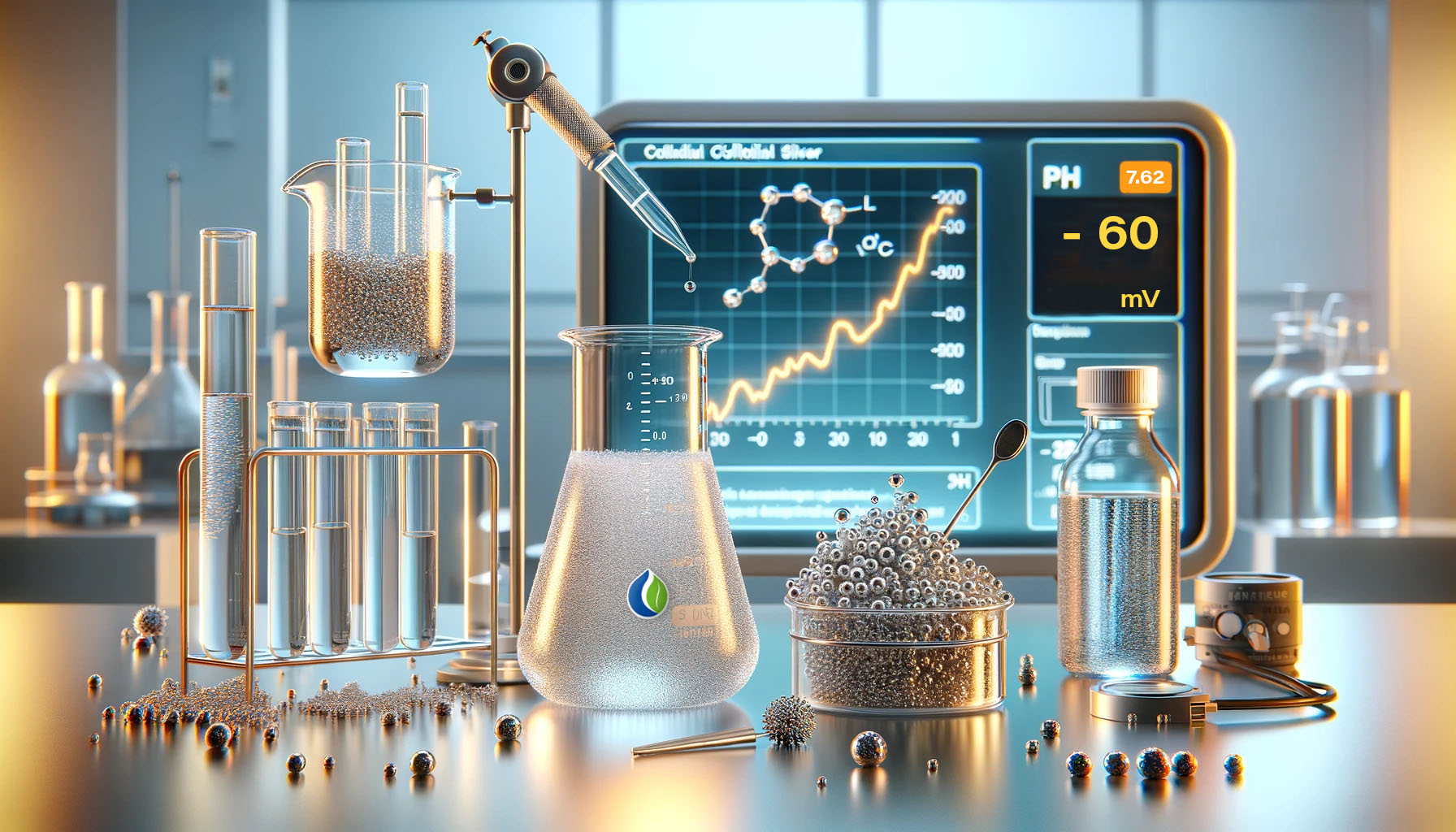
Welcome to our informative blog on colloidal silver! Discover the fascinating world of colloidal silver and dive deeper into the technical aspects that define this special product. From the production methods, the different forms of water used, particle size to the Zeta potential, we reveal the technical details you need to make an informed decision about colloidal silver. Broaden your knowledge and understanding of this fascinating topic. Read on and discover what colloidal silver has to offer on a technical level!
What is Colloidal Silver?
There is a lot of ambiguity in the world about what exactly colloidal silver is. It usually describes two types which, unfortunately, are used interchangeably by many providers, without actually knowing what they are offering:
Colloidal Ionic Silver:
Ionic silver refers to a solution in which silver is mainly in the form of charged ions. These ions are silver atoms that have lost electrons, making them positively charged. In ionic silver, there are no particles in suspension, as the silver ions are individually dissociated in the liquid. The dissolution of silver in ionic form can result from chemical processes.
Colloidal Nano silver:
Colloidal Nano silver, on the other hand, refers to a solution in which microscopic silver particles are suspended in a liquid. These particles can vary in size, but they are generally in the nano range, typically less than 100 nanometres. The stability of colloidal silver is often maintained by electrostatic repulsion between the particles, preventing them from aggregating.
Particle size:
In ionic silver, no silver particles are present because the silver is completely dissociated in ionic form. Colloidal Nano silver, on the other hand, consists of silver particles floating in the liquid. These particles typically have a size in the nano range, meaning they have very small dimensions. The precise size of the particles can vary depending on the manufacturing process and the specific formulation.
How Does It Work?
The silver particles in colloidal silver can vary in size and charge. These properties may play a role in their interaction with different substances. Although research into colloidal silver is still evolving, many are curious about its potential applications.
Colloidal silver is known for its unique characteristics and is sometimes applied in different sectors. From water purification to personal care, its versatile nature captures the imagination of people looking for alternative approaches.
What is Zeta Potential?
Zeta-Potential is a measure of the electrical charge on the particles in, among others, colloidal silver. For optimal results, colloidal silver should have a Zeta-Potential of -30 mV or lower. This means that the particles have a stable charge, improving their ability to bind to unwanted organisms.
Influence of pH on Zeta Potential
pH plays a vital role in determining Zeta Potential. A balanced pH is crucial for maintaining the optimum charge on the colloidal silver particles. Fluctuations in pH can affect the charge and thus reduce the effectiveness of colloidal silver.
Why is a Low Zeta Potential Important?
A low Zeta Potential ensures that colloidal silver particles remain evenly and stably distributed in the liquid. As a result, they retain their activity and potential to attack unwanted microorganisms. Aiming for a Zeta Potential of -30 mV or lower is a sign of high-quality colloidal silver products.
Distilled water versus Demineralised water
When it comes to the production of high-quality colloidal silver, the choice of water used is crucial. Distilled water proves to be the ideal partner here, for several reasons. Unlike demineralised water, which can still contain particles to which silver can react, distilled water offers a purity that maximises the effectiveness of colloidal silver.
The careful use of distilled water prevents unwanted reactions from taking place between silver particles and residual particles in the water. In the case of demineralised water, these remaining particles can affect and even nullify the action of the colloidal silver. This results in a product that does not meet the highest quality standards.
Moreover, silver reacts sensitively to various substances, such as chlorine. The use of distilled water minimises the presence of such reactive substances, ensuring the purity and stability of the colloidal silver.
Another crucial aspect that deserves attention is the influence of the choice of water used on the Zeta potential of colloidal silver. This potential, which indicates the stability of the silver particles, differs significantly when distilled water is used compared to demineralised water. Using demineralised water results in a higher Zeta potential (higher than -30mV), which disadvantages the stability of colloidal silver and negates its efficacy.
What should I look out for when buying colloidal silver?
Are you planning to purchase colloidal silver? Then it is essential to pay attention to some crucial factors to ensure you get a high-quality product. At Meditech Europe, we understand that the choice can be overwhelming, which is why we offer different types of colloidal silver with one notable feature: a high stability value, which translates to a low Zeta potential.
Stability, the Key to Effectiveness
When buying colloidal silver, stability is of paramount importance. The Zeta potential, a measure of stability, plays a crucial role here. Meditech Europe has dedicated itself to producing colloidal silver with a high stability value. This means that our colloidal silver remains stable for longer and is therefore more effective in retaining its desired properties. In the inserted charts, you can see the measurements of our colloidal silver, which show what the different colloids should look like:

You can see in this graph the Zeta Potential at the standard PH (7.4).
At the red and blue line, an acid is added to the colloidal silver. Here you can see the Zeta Potential go up (the value goes from -40 mV to about 5 mV). The conclusion from this is that with higher acidity, the Zeta Potential changes in a negative direction. The solution then becomes unstable, which generally means that the colloidal silver starts to clump together.
With the green and purple lines, an alkaline substance is added. Here you can see that alkalising the colloidal silver lowers the Zeta Potential (the value goes from -40 mV to -50/-60 mV). In conclusion, making the solution more alkaline lowers the Zeta Potential. The solution thus becomes more stable. It should be noted, however, that in this case it is possible that the alkaline particles may react with the silver particles, which means that it is therefore not wise to provide a more alkaline solution. This is strongly discouraged!
Discover the Proper Use of Colloidal Silver: Essential Guidelines
Colloidal silver is known for its versatile applications, but its correct use is crucial for optimal results. Follow these essential guidelines to get the most out of colloidal silver.
Avoid dilution:
It is essential not to dilute colloidal silver with other liquids. Use it as recommended by a qualified professional. Dilution can reduce efficacy and affect desired results.
Follow the Recommended Dosage:
Respect the recommended dosage to maximise benefits and minimise possible side effects. Overuse can be counterproductive, so exercise caution and follow instructions carefully.
Keep it Pure:
Use colloidal silver in its pure form with no additives. Adding other substances can alter its chemical composition and reduce its effectiveness.
Consult a Professional:
If you have any doubts about using colloidal silver, always consult a qualified professional. They can give personalised advice based on your needs.
By following these guidelines, you can get the most out of colloidal silver. Discover the right way to incorporate and experience the potential benefits.
Why choose Meditech Europe?
Meditech Europe has been a trusted name in colloidal silver manufacturing for many years. Our commitment to quality and reliability has made us one of the most respected manufacturers. If you are looking for a reliable supplier, you have come to the right place.
Comprehensive Information for an Informed Choice
At Meditech Europe, we believe in providing full transparency and comprehensive information about our products. We are ready to answer all your questions about colloidal silver and provide you with detailed information about the possibilities. Our aim is to enable you to make an informed choice that suits your needs and expectations.
FAQ
What is colloidal silver and how does it work?
Colloidal silver is a suspension of silver particles in water. These tiny particles can vary in size and are charged with an electrical charge. Although we make no health claims, colloidal silver has been used for centuries and enjoys popularity for its various uses. Find out more about its general properties and possible applications.
What is the Zeta potential of colloidal silver?
The Zeta potential is a measure of the stability of colloids, including colloidal silver. A lower Zeta potential indicates better solution stability. Want to learn more about the Zeta potential of colloidal silver? Get in touch with us!
Where can I buy good and reliable colloidal silver?
When buying colloidal silver, reliability is essential. Meditech Europe is known for its high-quality products. Discover our carefully crafted colloidal silver products and make an informed choice for your needs.
Conclusion
Would you like personalised advice? Meditech Europe is here for you! Contact us at info@meditecheurope.nl or call us at +31527 292 331. We will be happy to help you with information about our products and their use. At Meditech Europe, we strive to answer your questions and provide you with reliable information about colloidal silver.
